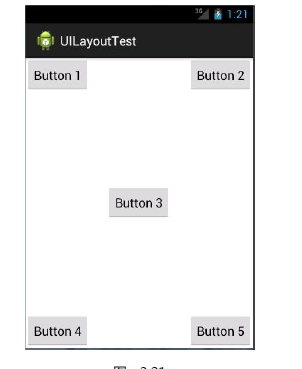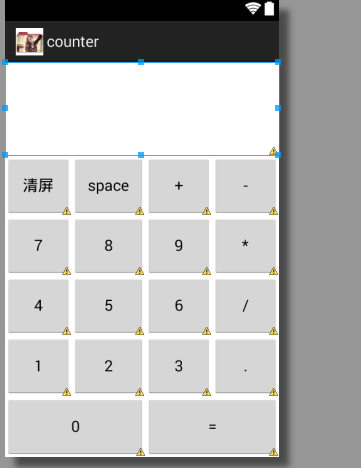android——相对布局,表格布局
1.相对布局
RelativeLayout 又称作相对布局,也是一种非常常用的布局。和LinearLayout 的排列规则不同,RelativeLayout 显得更加随意一些,它可以通过相对定位的方式让控件出现在布局的任何位置。也正因为如此,RelativeLayout 中的属性非常多,不过这些属性都是有规律可循的,其实并不难理解和记忆。
<RelativeLayout xmlns:android="http://schemas.android.com/apk/res/android"
android:layout_width="match_parent"
android:layout_height="match_parent" >
<Button
android:id="@+id/button1"
android:layout_width="wrap_content"
android:layout_height="wrap_content"
android:layout_alignParentLeft="true"
android:layout_alignParentTop="true"
android:text="Button 1" />
<Button
android:id="@+id/button2"
android:layout_width="wrap_content"
android:layout_height="wrap_content"
android:layout_alignParentRight="true"
android:layout_alignParentTop="true"
android:text="Button 2" />
<Button
android:id="@+id/button3"
android:layout_width="wrap_content"
android:layout_height="wrap_content"
android:layout_centerInParent="true"
android:text="Button 3" />
<Button
android:id="@+id/button4"
android:layout_width="wrap_content"
android:layout_height="wrap_content"
android:layout_alignParentBottom="true"
android:layout_alignParentLeft="true"
android:text="Button 4" />
<Button
android:id="@+id/button5"
android:layout_width="wrap_content"
android:layout_height="wrap_content"
android:layout_alignParentBottom="true"
android:layout_alignParentRight="true"
android:text="Button 5" />
</RelativeLayout>
效果图为

2.表格布局
TableLayout 允许我们使用表格的方式来排列控件,这种布局也不是很常用,你只需要了解一下它的基本用法就可以了。既然是表格,那就一定会有行和列,在设计表格时我们尽量应该让每一行都拥有相同的列数,这样的表格也是最简单的。不过有时候事情并非总会顺从我们的心意,当表格的某行一定要有不相等的列数时,就需要通过合并单元格的方式来应对。
<TableLayout xmlns:android="http://schemas.android.com/apk/res/android"
xmlns:tools="http://schemas.android.com/tools"
android:layout_width="match_parent"
android:layout_height="match_parent"
android:stretchColumns="*"
tools:context="com.calc.minicalculator.MainActivity" > <TextView
android:id="@+id/textView1"
android:layout_width="match_parent"
android:layout_height="109dp"
android:layout_gravity="center_horizontal|top"
android:gravity="right|center_vertical"
android:text="" android:textSize="40dp"
android:textStyle="bold" /> <TableRow
android:layout_weight="1"
android:id="@+id/tableRow1"
android:layout_width="wrap_content"
android:layout_height="match_parent" > <Button
android:id="@+id/button1"
android:layout_width="wrap_content"
android:layout_height="match_parent"
android:text="清屏" /> <Button
android:id="@+id/button2"
android:layout_width="wrap_content"
android:layout_height="match_parent"
android:text="space" /> <Button
android:id="@+id/button3"
android:layout_width="wrap_content"
android:layout_height="match_parent"
android:text="+" /> <Button
android:id="@+id/button4"
android:layout_width="wrap_content"
android:layout_height="match_parent"
android:text="-" /> </TableRow> <TableRow
android:layout_weight="1"
android:id="@+id/tableRow2"
android:layout_width="wrap_content"
android:layout_height="match_parent" > <Button
android:id="@+id/button5"
android:layout_width="wrap_content"
android:layout_height="match_parent"
android:text="7" /> <Button
android:id="@+id/button6"
android:layout_width="wrap_content"
android:layout_height="match_parent"
android:text="8" /> <Button
android:id="@+id/button7"
android:layout_width="wrap_content"
android:layout_height="match_parent"
android:text="9" /> <Button
android:id="@+id/button8"
android:layout_width="wrap_content"
android:layout_height="match_parent"
android:text="*" /> </TableRow> <TableRow
android:layout_weight="1"
android:id="@+id/tableRow3"
android:layout_width="wrap_content"
android:layout_height="match_parent" > <Button
android:id="@+id/button9"
android:layout_width="wrap_content"
android:layout_height="match_parent"
android:text="4" /> <Button
android:id="@+id/button10"
android:layout_width="wrap_content"
android:layout_height="match_parent"
android:text="5" /> <Button
android:id="@+id/button11"
android:layout_width="wrap_content"
android:layout_height="match_parent"
android:text="6" /> <Button
android:id="@+id/button12"
android:layout_width="wrap_content"
android:layout_height="match_parent"
android:text="/" /> </TableRow> <TableRow
android:layout_weight="1"
android:id="@+id/tableRow4"
android:layout_width="wrap_content"
android:layout_height="match_parent" > <Button
android:id="@+id/button13"
android:layout_width="wrap_content"
android:layout_height="match_parent"
android:text="1" /> <Button
android:id="@+id/button14"
android:layout_width="wrap_content"
android:layout_height="match_parent"
android:text="2" /> <Button
android:id="@+id/button15"
android:layout_width="wrap_content"
android:layout_height="match_parent"
android:text="3" /> <Button
android:id="@+id/button19"
android:layout_width="wrap_content"
android:layout_height="match_parent"
android:text="." /> </TableRow> <TableRow
android:layout_weight="1"
android:id="@+id/tableRow5"
android:layout_width="wrap_content"
android:layout_height="match_parent"
> <Button
android:id="@+id/button17"
android:layout_width="wrap_content"
android:layout_height="match_parent"
android:text="0"
android:layout_span="2"
/> <Button
android:id="@+id/button16"
android:layout_width="wrap_content"
android:layout_height="match_parent"
android:text="="
android:layout_span="2"/> </TableRow> </TableLayout>
效果图:

android——相对布局,表格布局的更多相关文章
- 第24讲 UI_布局 之帧布局 表格布局 绝对布局
第24讲 UI_布局 之帧布局 表格布局 绝对布局 3. FrameLayout(帧布局) 帧布局是从屏幕的左上角(0,0)坐标开始布局,多个组件层叠排序,后一个组件总会将前一个组件所覆盖,除非最后一 ...
- Android布局— — —表格布局
表格布局 以表格的形式来显示界面中的控件,表格的每一行为一个TableRow,每当一个控件添加到TableRow中,就生成一个单元格. 语法格式: <TableLayout xmlns:andr ...
- .Net程序猿玩转Android开发---(8)表格布局TableLayout
表格布局TableLayout是Android中比較经常使用的一个布局控件,既然是表格,肯定有行和列,TableLayout中的行有TableRow组成.列依据每行控件的数量来确定 假如第一行有3个控 ...
- Android 自学之表格布局 TableLayout
表格布局(TableLayout),表格布局采用行.列的形式来管理UI组件,TableLayout并不需要明确的声明多少行,多少列,而是通过TableRow.其他组件来控制表格的行数和列数. 每次想T ...
- Android中的表格布局TableLayout
表格布局最基本的三个属性: XML代码实例: <?xml version="1.0" encoding="utf-8"?> <LinearLa ...
- Android笔记(十) Android中的布局——表格布局
TableLayout运行我们使用表格的方式来排列控件,它的本质依然是线性布局.表格布局采用行.列的形式来管理控件,TableLayout并不需要明确的声明包含多少行多少列,而是通过添加TableRo ...
- Android之TableLayout表格布局
1.相关属性 1.1.常用属性 android:collapseColumns 设置需要被隐藏的列的序列号 android:shrinkColumns 设置允许被收缩的列的序列号 android:st ...
- android:TableLayout表格布局详解
1.TableLayout简介2.TableLayout行列数的确定3.TableLayout可设置的属性详解4.一个包含4个TableLayout布局的实例及效果图一.Tablelayout简介 ...
- Android开发-之五大布局
在html中大家都知道布局是什么意思了,简单来说就是将页面划分模块,比如html中的div.table等.那么Android中也是这样的.Android五大布局让界面更加美化,开发起来也更加方便.当然 ...
- 【转】TableLayout(表格布局)
转自:http://www.cnblogs.com/zhangs1986/archive/2013/01/17/2864536.html TableLayout(表格布局) 表格布局模型以行列的形式管 ...
随机推荐
- Device Tree(二):基本概念
转自:http://www.wowotech.net/linux_kenrel/dt_basic_concept.html 一.前言 一些背景知识(例如:为何要引入Device Tree,这个机制是用 ...
- 【Java EE 学习 77 上】【数据采集系统第九天】【通过AOP实现日志管理】【通过Spring石英调度动态生成日志表】【日志分表和查询】
一.需求分析 日志数据在很多行业中都是非常敏感的数据,它们不能删除只能保存和查看,这样日志表就会越来越大,我们不可能永远让它无限制的增长下去,必须采取一种手段将数据分散开来.假设现在整个数据库需要保存 ...
- .Net中Remoting通信机制
Remoting通信机制 Remoting介绍 主要元素 通道类型 激活方式 对象定义 Remoting介绍 什么是Remoting,简而言之,我们可以将其看作是一种分布式处理方式. 从微软的产品角度 ...
- winform快速开发平台 -> 快速绑定ComboBox数据控件
通常我们在处理编辑窗体时.往往会遇到数据绑定.例如combobox控件绑定数据字典可能是我们经常用到的.然而在我的winform快速开发平台中我是如何处理这个频繁的操作呢? 首先,我们要绑定combo ...
- 数量经济学推荐的Julia教程
http://quant-econ.net/jl/learning_julia.html Julia最为号称和c媲美的运行速度,想python一下简单的语法,虽然发展还不完善,但任然值得去关注. Ju ...
- mysql 连接池超时
var mysql = require('mysql'); var pool = mysql.createPool({ host: 'localhost', user: 'nodejs', passw ...
- 网站Bannr适应大小屏幕,图片始终居中不被压缩
网站banner一般都是2000px以上的宽度,为了让在小的屏幕上图片不被压缩并且是居中表现: 方法是让包裹图片全部的那个大容器始终正居中 <!-- banner --> <div ...
- ci框架登陆之后每隔几分钟就需要重新登录的问题
一个简单的登陆写好之后,发现每次进入需要登陆之后才能进入的页面都会跳转到登录页面,猜测应该是session被清了,打印出来,果然为空,但是我没有设置session的生存周期,按照默认的应该是24小时, ...
- 【github问题】error: src refspec master does not match any解决方法|please tell me who you are
http://www.open-open.com/lib/view/open1366080269265.html这个先记录一下省得以后再找 我这里要解决的问题根本是:please tell me wh ...
- OSG消息机制之事件处理概述
OSG的消息机制包括好多个头文件预定义及多个类. 首先,消息接收相关的类当属osgGA::GUIEventHandler和osgGA::GUIEventAdapter这两个类了.前者处理OSG程序与用 ...
